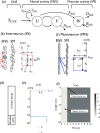A mathematical model of human oesophageal motility function
- PMID: 40843188
- PMCID: PMC12365353
- DOI: 10.1098/rsos.250491
A mathematical model of human oesophageal motility function
Abstract
Recent advances in various observation methods revealed several unique characteristics of oesophageal peristalsis and its disorders. However, a framework for understanding the oesophageal motility pattern is lacking. Here, we propose a simple mathematical model of the human oesophageal motility function. The model comprises central nervous system signals, enteric nervous system neurons (interneurons and motoneurons) and oesophageal smooth muscles. The neural function implements excitable dynamics at the oesophageal body and toggle-switch dynamics at the lower oesophageal sphincter. The local signal transmission in enteric nervous system and 'the law of the intestine' were also incorporated. The model behaviours can be understood using mathematical analysis, and we could reproduce the physiological dynamics of the normal oesophagus-deglutitive inhibition, unidirectional pulse transmission, restoration of lower oesophageal sphincter constriction and dilatation of the anal side of the pulse. In addition, we could reproduce various pathological motility patterns described in the Chicago classification by the combinations of parameter changes, which may provide insights into the possible pathogenesis of these disorders.
Keywords: high-resolution manometry; mathematical modelling; oesophageal motility.
© 2025 The Authors.
Conflict of interest statement
T.M.,H.I., Y.H., H.T.-I., K.S., S.-I.E., E.I., and Y.O. declare no conflict of interest in this study.
Figures






Similar articles
-
Prescription of Controlled Substances: Benefits and Risks.2025 Jul 6. In: StatPearls [Internet]. Treasure Island (FL): StatPearls Publishing; 2025 Jan–. 2025 Jul 6. In: StatPearls [Internet]. Treasure Island (FL): StatPearls Publishing; 2025 Jan–. PMID: 30726003 Free Books & Documents.
-
Use of endoanal ultrasound for reducing the risk of complications related to anal sphincter injury after vaginal birth.Cochrane Database Syst Rev. 2015 Oct 29;2015(10):CD010826. doi: 10.1002/14651858.CD010826.pub2. Cochrane Database Syst Rev. 2015. PMID: 26513224 Free PMC article.
-
Azithromycin and oesophageal motility in chronic respiratory disease: a feasibility study.Ther Adv Respir Dis. 2025 Jan-Dec;19:17534666251360065. doi: 10.1177/17534666251360065. Epub 2025 Jul 29. Ther Adv Respir Dis. 2025. PMID: 40734318 Free PMC article.
-
Surveillance of Barrett's oesophagus: exploring the uncertainty through systematic review, expert workshop and economic modelling.Health Technol Assess. 2006 Mar;10(8):1-142, iii-iv. doi: 10.3310/hta10080. Health Technol Assess. 2006. PMID: 16545207
-
DeePosit, an AI-based tool for detecting mouse urine and fecal depositions from thermal video clips of behavioral experiments.Elife. 2025 Aug 28;13:RP100739. doi: 10.7554/eLife.100739. Elife. 2025. PMID: 40874843 Free PMC article.
References
-
- Hall JE. 2021. Guyton and hall textbook of medical physiology, 14th edn. Philadelphia, PA, USA: Elsevier.
-
- Mashimo H, Goyal RK. 2006. Physiology of esophageal motility. GI Motility Online. ( 10.1038/gimo3) - DOI
Associated data
LinkOut - more resources
Full Text Sources

